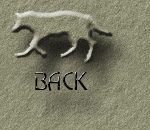Canis
familiaris dingo - Dingo
Range: Australia
Size: 20 - 49 lb (9
- 22 kg)
The dingo is usually
classified as a subspecies (C. familiaris
dingo) of the domestic dog. An inhabitant
of Australia, it was introduced to that continent by human settlers which
migrated from Asia. This introduction probably occurred between 4,000
- 8,000 years ago, though some authorities place the date at only 3,500
- 4,000 years. The oldest verified dingo remains yet found have been
carbon dated to an age of 3,450 years. Some believe that the dingo
may be a descendant of the Indian Grey wolf (Canis lupus pallipes).
Additionally, it its theorized that the pre-Australian form of the dingo,
or a breed very similar to it, may be ancestral to most or all of today's
400+ recognized breeds of domestic dogs (with the exception of some of
the breeds originating from the far north, which more likely were developed
from a larger, northern subspecis of wolf). Dingoes are actually
rather physically distinct from other breeds of dogs which occur in nearby
New Guinea and Indonesia. Although similar in colouration, breeds
such as the New Guinea singing dog (so named for its odd vocalizations),
are much smaller and stouter in general. |
 ANIMAL
DIVERSITY WEB - DINGO
ANIMAL
DIVERSITY WEB - DINGO
